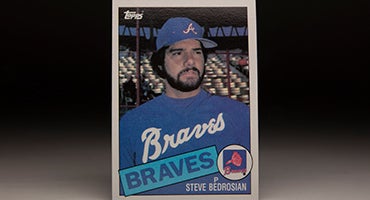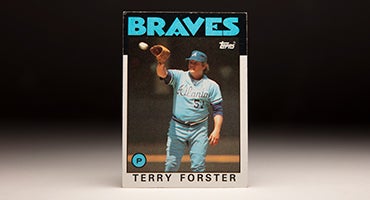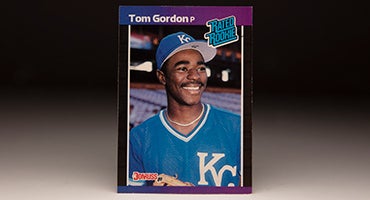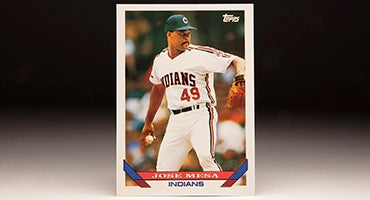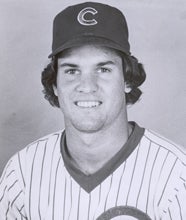- Home
- Our Stories
- #CardCorner: 1989 Topps Mike Jackson
#CardCorner: 1989 Topps Mike Jackson
One of just 16 pitchers in history to appear in at least 1,000 games, Mike Jackson toiled as a set-up man for most of his 17 big league seasons.
But when the right-handed fastballer had the chance to be the stopper, Jackson proved effective – and nearly pitched Cleveland to a World Series title.
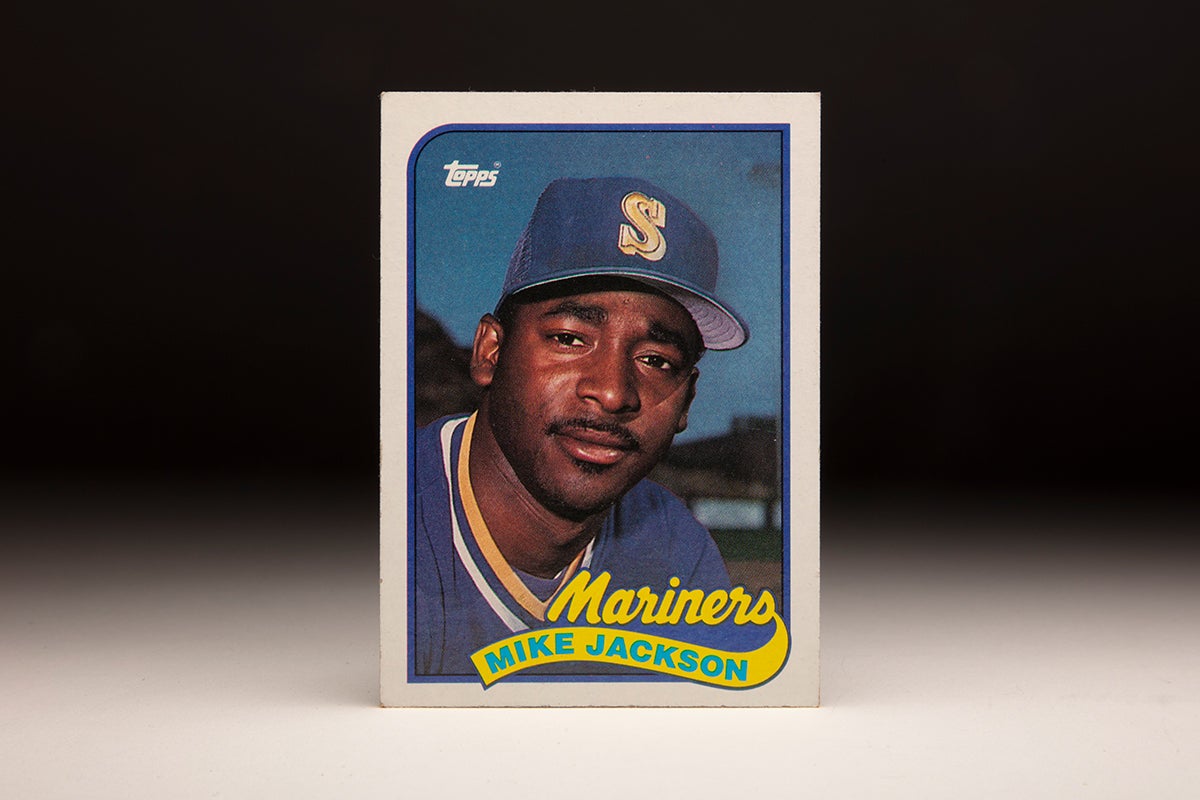
Michael Ray Jackson was born Dec. 22, 1964, in Houston, Texas. He played football and baseball at Forest Brook High School and was good enough on the gridiron to earn offers from Kansas and North Texas State.
But Jackson hurt his left knee playing football his senior year, and after one baseball game that spring his knee gave out. He soon underwent surgery for torn cartilage and ligaments.
He was selected by the Phillies in the 29th round of the 1983 MLB Draft but opted to enroll at Hill College in Hillsboro, Texas. There, Jackson played infield and pitched, and the Phillies selected Jackson again in the second round of the January 1984 draft. This time, Jackson signed for a reported $60,000 bonus and the Phillies immediately made him a fulltime pitcher.
Sent to Spartanburg of the Class A South Atlantic League, Jackson went 7-2 with a 2.68 ERA over 14 starts in 1984. He pitched for Peninsula of the Carolina League the following year, going 7-9 with a 4.60 ERA while serving as both a starter and reliever.
Then in 1986, the Phillies made Jackson a fulltime reliever. He was ticketed for Class A Clearwater that year but injuries brought him to Double-A Reading.
“He was going to be a spot starter, long reliever, really the 10th man on the staff,” Reading manager George Culver told the Lebanon (Pa.) Daily News. “I figured once some of those kids at Clearwater were healthy enough to pitch, Jackson would go there.
“He showed a really good fastball. His curve kind of tumbled up there, though, and his change was inconsistent. All of a sudden, he began to throw his curveball hard and it became nasty. (When) he became our stopper around June, I knew he could pitch higher and the big leagues wasn’t far away.”
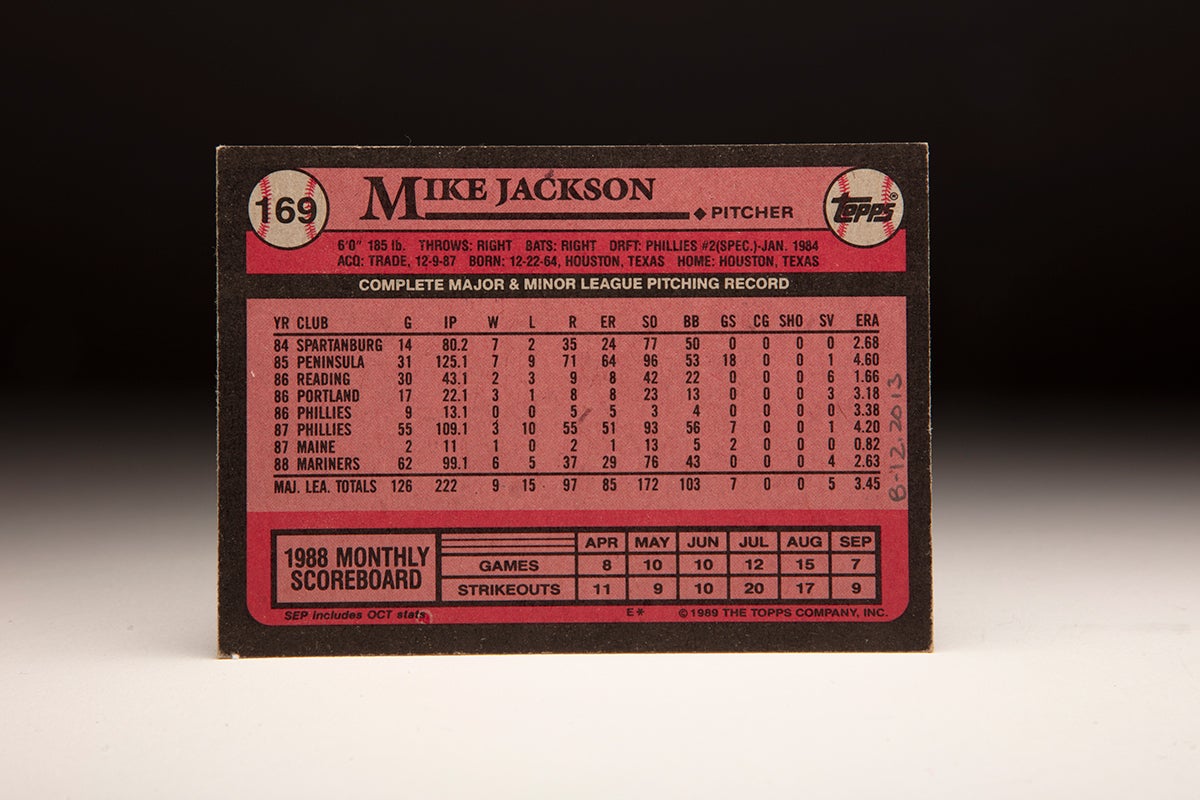
Jackson thrived at Double-A Reading, going 2-3 with six saves and a 1.66 ERA in 30 games. Earning a promotion to Triple-A on July 4, Jackson pitched in 17 games for Portland, going 3-1 with three saves.
On Aug. 7 following a four-game sweep at the hands of the Cardinals, the Phillies released lefty reliever Tom Gorman and brought Jackson to the big leagues.
“We’re going to find out what he can do,” Phillies manager John Felske told the News Journal of Wilmington, Del. “We’ve been thinking about this for a while. I’d rather have two left-handers in the bullpen but we need to get some answers.”
Jackson made his big league debut on Aug. 11, pitching a scoreless inning against the Mets. He would work a total of nine games down the stretch, allowing 12 hits over 13.1 innings but curiously striking out just three batters.
At this point, Jackson began to transition from “Michael” to “Mike” to avoid the inevitable comparisons with the world-famous pop singer of the same name.
“Mike or Michael, I really don’t care,” Jackson told the Lebanon Daily News. “I sign ‘Mike’ and all the guys I’ve played with call me that.”
Except for two starts with Triple-A Maine where he struck out 13 batters over 11 innings, Jackson spent the entire 1987 season with the Phillies. He appeared in 55 games, going 3-10 with a 4.20 ERA over 109.1 innings, which included eight starts from mid-May to mid-June. Jackson had begun the year in the bullpen and had a 1.86 ERA over 13 appearances before the Phillies moved him to the rotation.
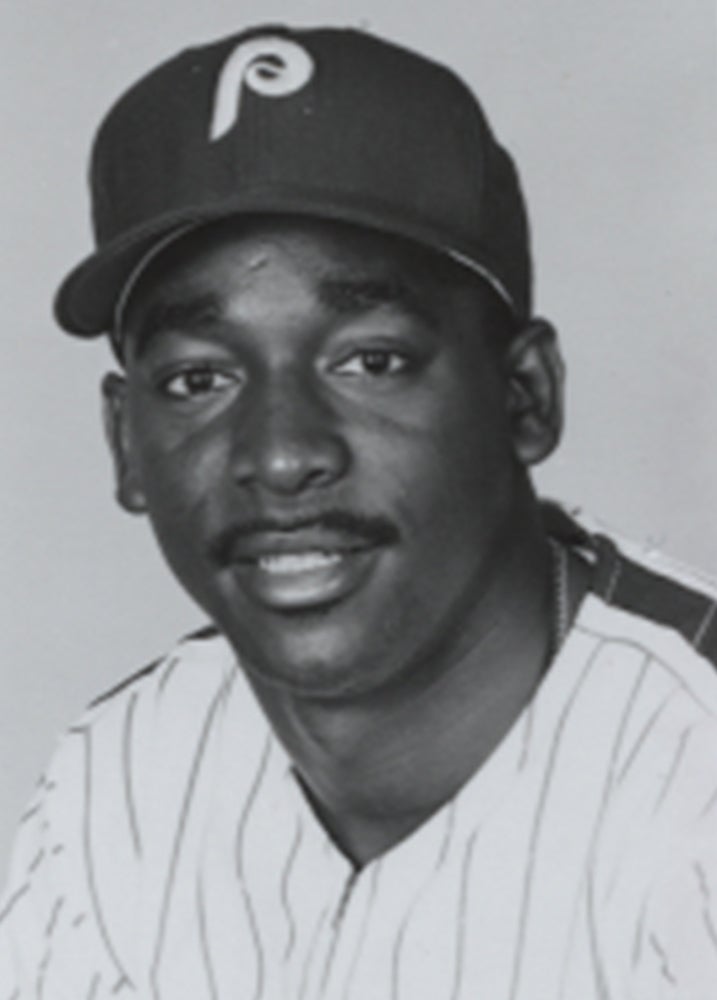
On June 7, Jackson held the Expos hitless for eight innings before yielding two hits and a run in the ninth as Steve Bedrosian closed out a 3-1 win – Jackson’s first big league victory. But it soon became clear that Jackson was more effective as a reliever.
“We might entertain the thought of making Jackson a starter,” Phillies manager Lee Elia, who replaced Felske midway through the season, told the News Journal at the end of the campaign. “He admits he’d rather be in the bullpen but it depends on what happens in the winter. Personally, I’d like to leave him in the bullpen.”
But Elia never got the chance. On Dec. 9, Jackson was traded to the Mariners with Glenn Wilson and a minor leaguer in exchange for Phil Bradley and Tim Fortugno. He pitched the next four seasons for Seattle and appeared to be in line to be the team’s closer. But Jackson remained in a setup role for most of that time.
Mike Schooler got most of the save opportunities from 1988-90. Jackson went 6-5 with a 2.63 ERA over 62 games in 1988 and 4-6 with a 3.17 ERA in 65 games in 1989 – working 99.1 innings in each season.
He struggled in 1990 with a 5-7 record and 4.54 ERA over 63 games but bounced back in 1991 when Schooler missed the first half of the season with a shoulder injury. Jackson and Bill Swift shared the closer duties in Schooler’s absence, and Jackson finished the season with a 7-7 record and 14 saves over 72 games, striking out 74 batters in 88.2 innings.
Then on Dec. 11, 1991, the Mariners traded Jackson, Swift and Dave Burba to the Giants in exchange for former National League MVP Kevin Mitchell and Mike Remlinger.
“When the Giants came to the Winter Meetings,” San Francisco general manager Al Rosen told the Associated Press, “the quest was pitching.”
In Jackson, Rosen got a reliever who would make their bullpen one of the best in the game.
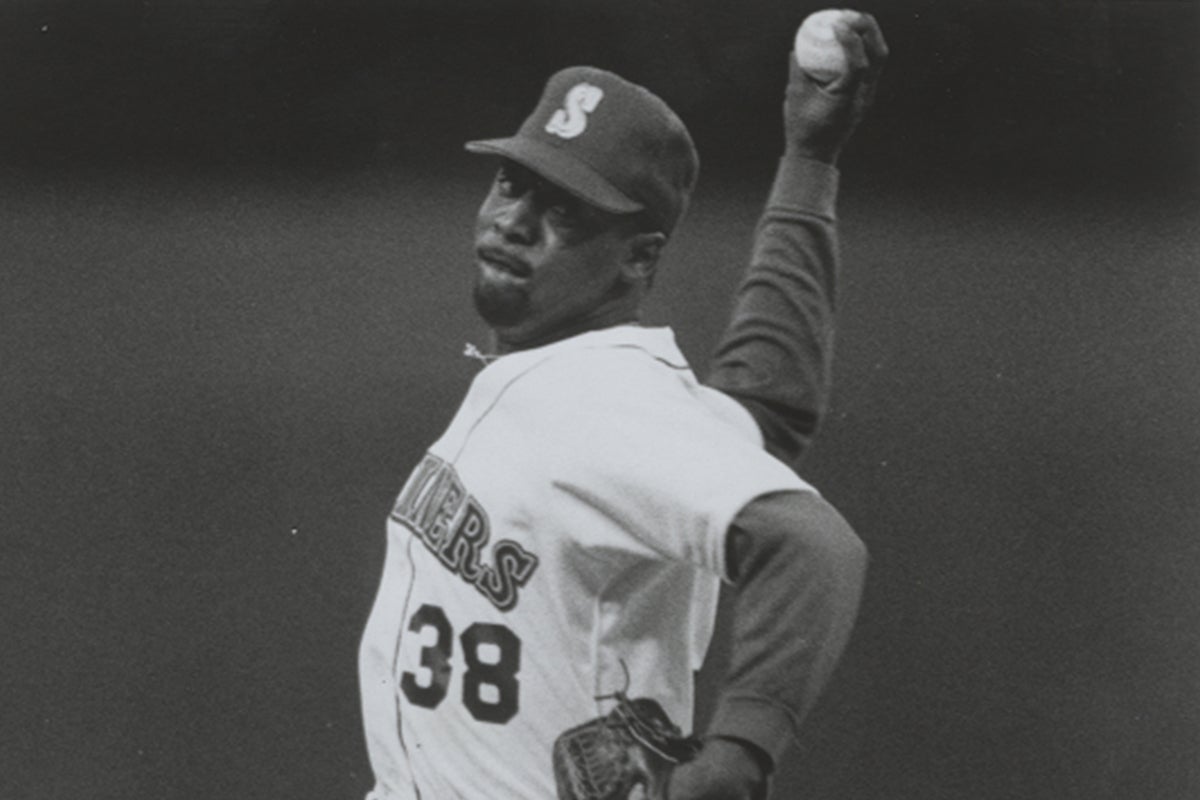
In 1992, Jackson went 6-6 with two saves and a 3.73 ERA in 67 games as a setup man for Rod Beck. The Giants lost 90 games that year, and longtime manager Roger Craig was replaced in the offseason by Dusty Baker. The Giants weren’t expected to contend in 1993 but took a different tone under Baker – an attitude that became clear when Jackson hit Ryne Sandberg in his left hand with a pitch on March 6, 1993, fracturing his pinky. The incident triggered a rare Spring Training benches-clearing mele.
Cubs manager Jim Lefebvre believed Jackson was not trying to hit Sandberg.
“(Jackson is) just wild with his fastball,” Lefebvre told the Republic. “He’s always been inconsistent. The ball just got away from him.”
Baker utilized his bullpen early and often that season as Beck totaled 48 saves. Jackson appeared in an MLB-leading 81 games, going 6-6 with a 3.03 ERA over 77.1 innings.
On July 23, 1993, Jackson got tangled up with first baseman Will Clark and Phillies runner Dave Hollins on a play at first base and injured his right knee, sidelining him for two weeks. He was leading the National League in appearances with 56 when he was injured and was still leading the league on Aug. 9 when he returned from the disabled list.
He pitched in 14 games in September alone before working in each of the Giants’ three October games against the Dodgers as the Giants and Braves battled for the NL West title. Jackson notched his 33rd and 34th holds of the season Oct. 1-2 vs. Los Angeles, setting up a season finale where the Giants and Braves both entered play with 103 wins. But the Dodgers defeated the Giants 12-1 while Atlanta beat Colorado, giving the Braves a ticket to the postseason.
Jackson worked two-thirds of an inning in the season’s final game, allowing a sixth-inning single to Eric Karros that plated the Dodgers’ seventh run in a game that was already out of reach. The Giants’ entire pitching staff was exhausted following the frantic pennant race.
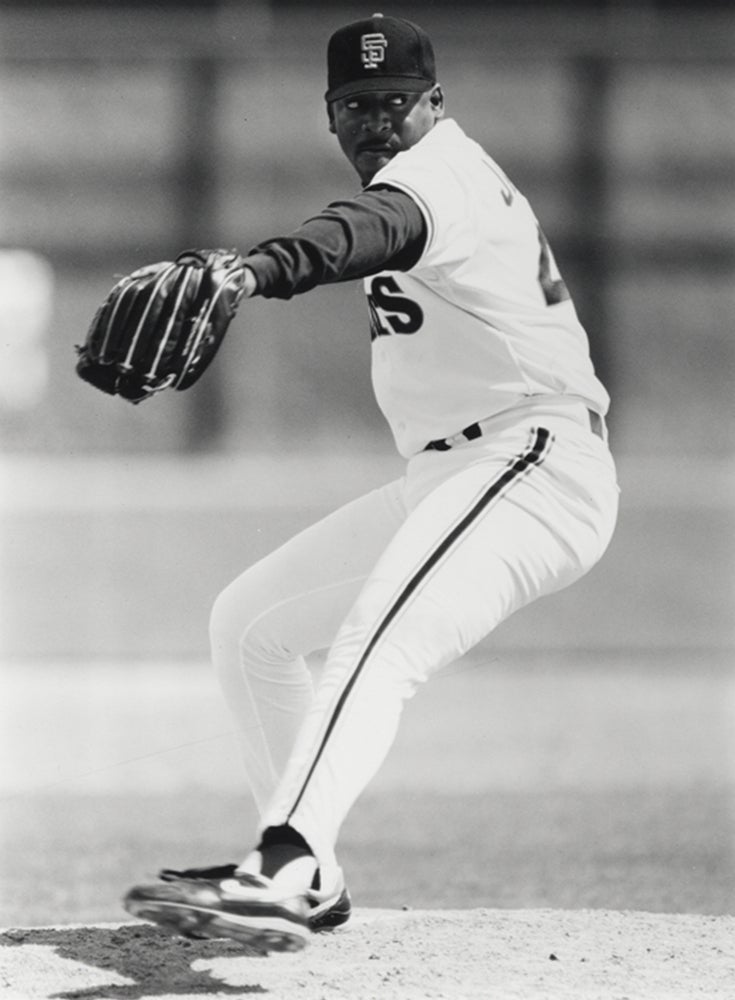
The Giants were unable to repeat their success in 1994, finishing the strike-shortened season at 55-60 and in second place in the NL West. Jackson, however, was having a stellar season until tendinitis in his right elbow sidelined him for the rest of the season in July. In 36 games, Jackson went 3-2 with four saves and a 1.49 ERA while fanning 51 batters in 42.1 innings.
A free agent when baseball resumed in the spring of 1995, Jackson signed a one-year deal with the Reds. He did not make his first appearance until June 6 due to injuries but quickly settled in as the primary setup man for closer Jeff Brantley, going 6-1 with a 2.39 ERA in 40 games as the Reds won the NL Central title.
He pitched in all three games of the NLDS vs. the Dodgers in his first postseason action, allowing four hits and no runs over 3.2 innings as the Reds swept the series. But Cincinnati was swept in the NLCS by the Braves as Jackson took the loss in Game 1, allowing a two-out, 11th inning RBI single to Mike Devereaux that gave Atlanta a 2-1 win. He appeared in two more contests in the series, pitching a scoreless inning in Game 2 before allowing five runs in one-third of an inning in Game 4.
A free agent once again, Jackson returned to the Mariners on a one-year deal for 1996. He turned in a typical performance – a 1-1 record and six saves in 73 games with a 3.63 ERA – before signing a two-year deal with Cleveland worth a reported $4.2 million on Dec. 12, 1996.
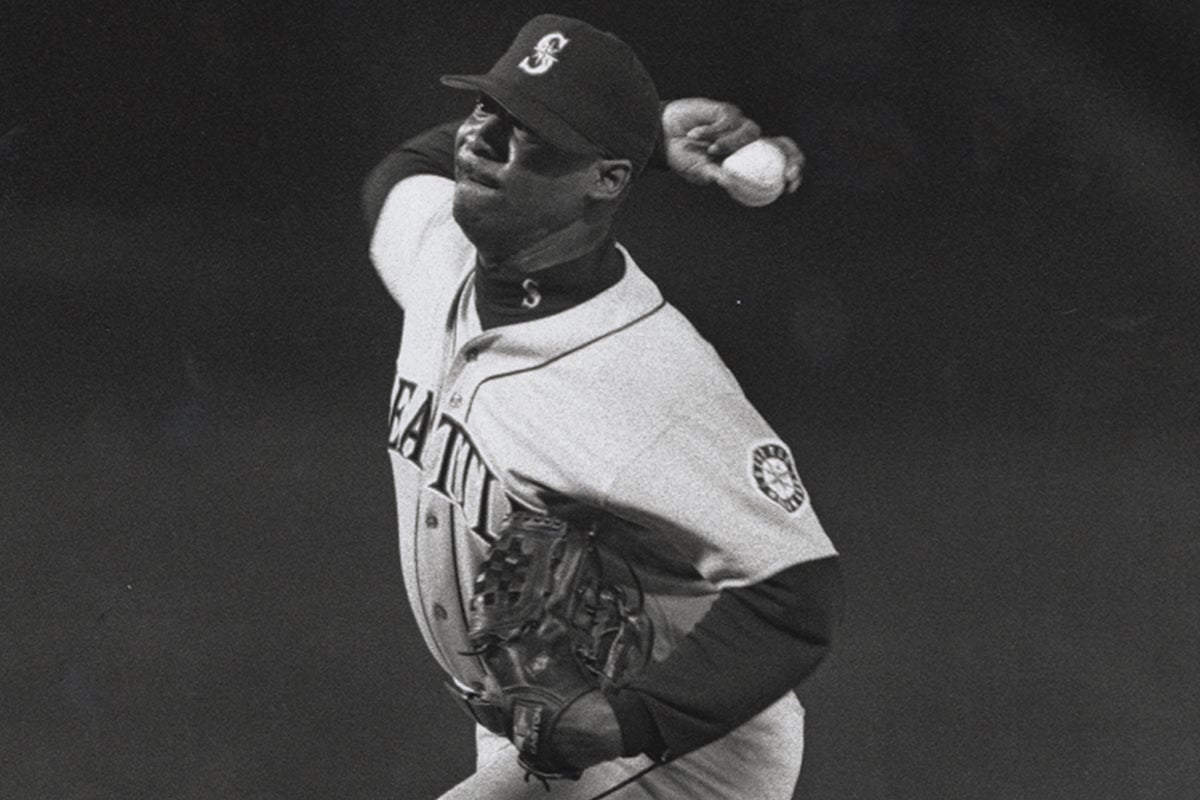
Slated to be the setup man for José Mesa, Jackson found himself closing games regularly for the first time since 1991 when Mesa struggled early in the season. But manager Mike Hargrove returned Mesa to the closer’s role in August as Cleveland won the AL Central to advance to the postseason. Jackson finished the regular season with a 2-5 record, 15 saves and a 3.24 ERA in 71 games.
In the postseason, Jackson was at his best. He pitched in four of the five ALDS games vs. the Yankees, picking up a win in the critical Game 4 as Cleveland staved off elimination. He struck out five over 4.1 innings in the series and did not allow a run. Then in the ALCS vs. Baltimore, Jackson worked in five games and again did not allow anyone to score, this time striking out seven batters in 4.1 innings as Cleveland defeated the Orioles in six games.
In the World Series against Florida, Jackson worked 1.1 shutout innings in Game 2 before allowing his first runs of the postseason in Game 3. He entered the contest with a man on second and one out in the top of the seventh with Cleveland leading 7-5 in a frigid night at Jacobs Field, permitting Florida to tie the game on a single by Édgar Rentería and a double by Gary Sheffield. Florida would win that game 14-11 but Jackson would return in Game 6 to pitch two shutout innings in Cleveland’s 4-1 win.
In the final game, Cleveland led 2-1 entering the bottom of the eighth after rookie Jaret Wright permitted just two hits and one run over 6.1 innings and Paul Assenmacher closed out the bottom of the seventh. Hargrove called on Jackson to pitch the eighth, and Jackson retired Rentería on a groundout before striking out Sheffield. With lefty Darren Daulton due up next, Hargrove called on left-hander Brian Anderson and removed Jackson from the game. Marlins manager Jim Leyland countered with pinch-hitter Jeff Conine, but Anderson retired Conine on a fly ball to left to end the inning.
Cleveland was now three outs away from a title. But by lifting Jackson, Hargrove was committed to using Mesa in the ninth. Cleveland had no trusted relievers beyond that.
The Marlins rallied to tie the score in the bottom of the ninth off Mesa, and Mesa and starter Charles Nagy combined to get out of a two-on, one-out situation in the 10th. But with the score still tied in the bottom of the 11th, Nagy surrendered an RBI single to Rentería to end the game and the World Series.
Jackson finished the 1997 postseason with an ERA of 0.68.
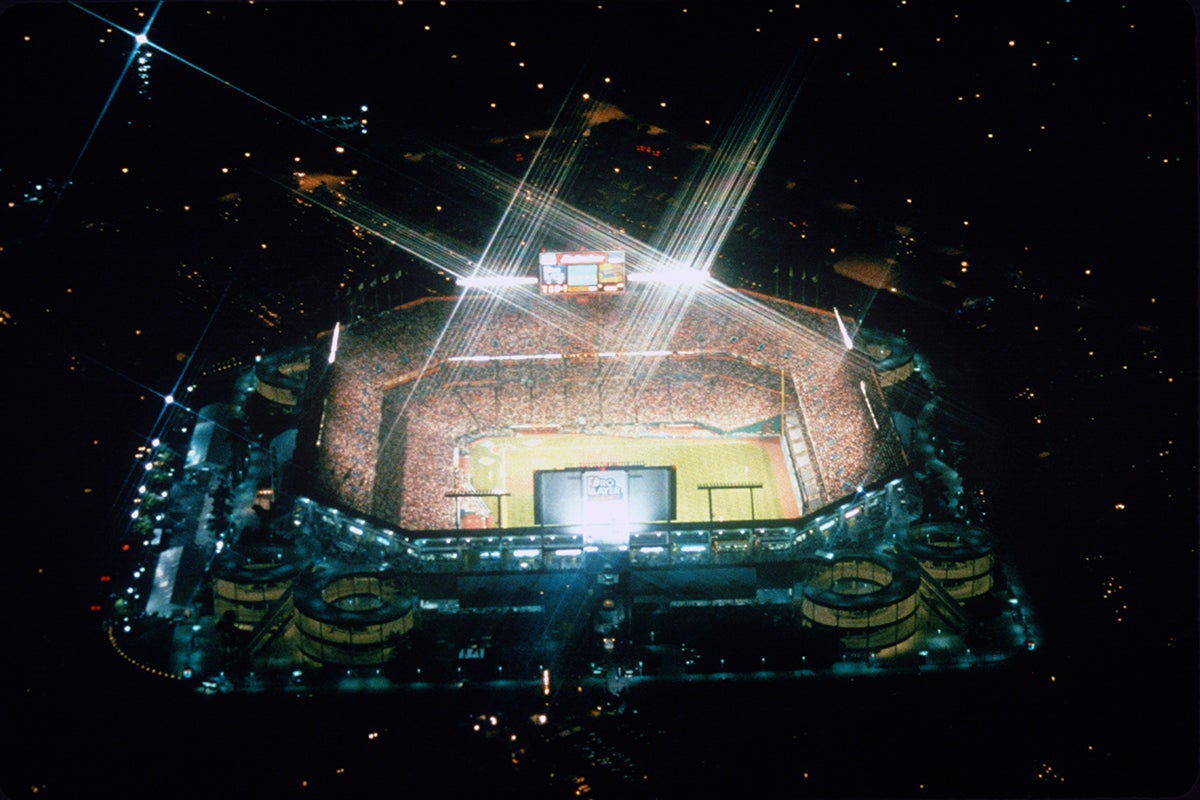
With Mesa now a target of boo birds in Cleveland, Jackson took over the closer’s role in 1998. He thrived in the job and had 24 saves through July 22. The next day, Cleveland traded Mesa to the Giants, and Jackson continued to rack up saves the rest of the way – finishing the year with a 1-1 record, 40 saves (with just five blown saves) and a 1.55 ERA in 69 games. His save total was at the time the third-best single-season mark in franchise history, trailing only Mesa in 1995 (46) and Doug Jones in 1990 (43).
Cleveland again won the AL Central, and Jackson had three saves in the ALDS vs. Boston as the Indians won the series in four games. But New York beat Cleveland in six games in the ALCS, with Jackson recording a save in his only appearance in Game 2. After Cleveland won Game 3 to take a 2-games-to-1 lead, the Yankees won three straight by an aggregate score of 18-8.
Cleveland exercised an option on Jackson’s contract and brought him back for the 1999 season. And while he was once again effective – saving 39 games with only four blown chances – the wear and tear of 12 big league seasons began to take its toll, evidenced by his 4.06 ERA. Cleveland advanced to the ALDS again but this time lost to Boston as Jackson allowed one run over two appearances in the five-game series.
Jackson was once again a free agent and again reunited with one of his former teams, signing a one-year deal with the Phillies worth a reported $3 million on Dec. 7, 1999. But while warming up for his first regular season game on April 6, Jackson felt stiffness in his shoulder. He eventually underwent surgery and missed the entire campaign.
“Signing (Jackson) was the right thing to do,” Phillies general manager Ed Wade told the Camden, N.J., Courier-Post. “This (shoulder) problem wasn’t there. On all the MRIs we had done, the back of his shoulder was unremarkable. We knew about the labrum and the elbow (issues), but the capsule in the back of his shoulder was not an issue.”
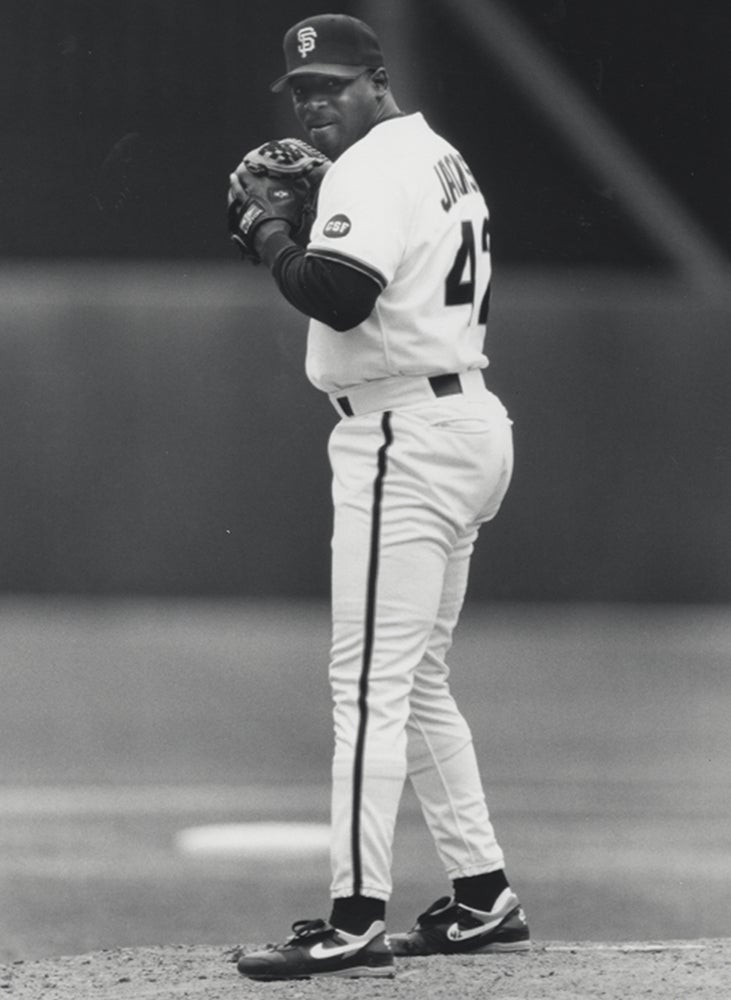
Jackson returned home for his next stop, signing with the Astros on Dec. 14, 2000. He pitched in 67 games in 2001, going 5-3 with four saves and a 4.70 ERA – serving as the closer for about a month when Billy Wagner was injured. In the NLDS vs. Atlanta, he pitched in two games – taking the loss in Game 1 as the Braves swept the series.
He moved onto the Twins in 2002, joining the team after MLB nearly eliminated it in a contraction effort and working 58 games, going 2-3 with a 3.27 ERA as Minnesota won the AL Central on the strength of a league-leading 45 saves by closer Eddie Guardado.
“We really didn’t know if we would be playing this year,” Jackson told the AP. “It’s a great feeling. I wasn’t here last year when they went through all this stuff. But when they asked me to come over here and play, I looked at everything they had and knew I wanted to come and be a part of it.”
Jackson pitched in one game in the ALDS vs. Oakland, allowing no runs in two-thirds of an inning. In the ALCS vs. the Angels, he appeared in the final three postseason games of his career, allowing a pair of hits and striking out two batters in Game 2, walking the only batter he faced in Game 3 and then allowing three earned runs without retiring a hitter in Game 4.
His postseason work in 2001 and 2002 left his career ERA in the playoffs at 4.71 over 31 games. But if those last two years are factored out, Jackson’s ERA is 3.42.
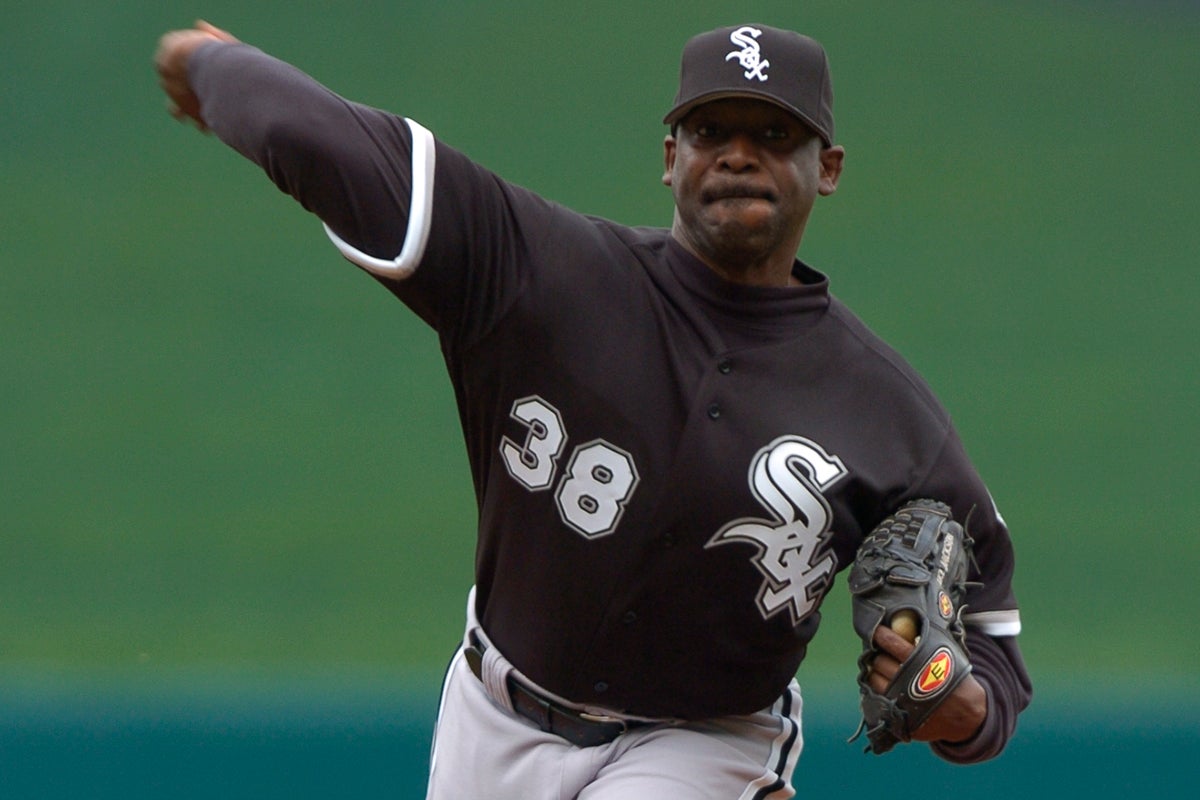
Jackson signed with the Diamondbacks for 2003 but was released on March 29. He returned to the big leagues in 2004 with the White Sox and spent most of the season with the team before being released on Sept. 2 while sporting a 2-0 record and 5.01 ERA over 45 games. With that, Jackson’s playing career came to a close.
In 17 seasons, Jackson was 62-67 with 142 saves and a 3.42 ERA in 1,005 games. He finished with 1,006 strikeouts, averaging one per game in a career that saw him pitch 998 games out of the bullpen. Not bad for a former 29th-round draft choice with a bad knee.
“It seemed like I was walking a mile,” Jackson told the Lebanon (Pa.) Daily News about heading to the mound for his big league debut on Aug. 11, 1986. “It’s hard to describe, the feeling I had.”
Craig Muder is the director of communications for the National Baseball Hall of Fame and Museum

